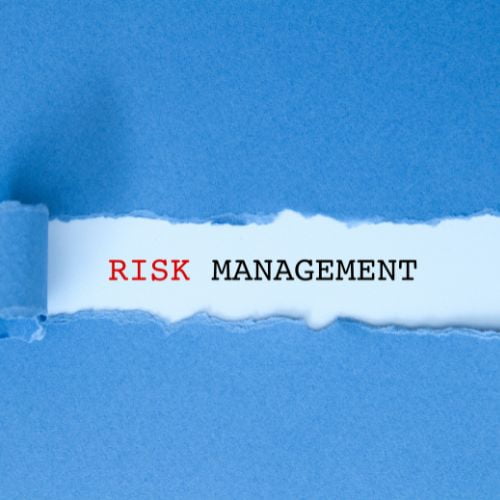
Not only is using a fixed asset register a good practice for daily operations, but it also helps you maintain control over your company’s vital resources. A structured asset register makes tracking both fixed and non-fixed assets possible, guaranteeing appropriate maintenance, security, and availability as needed. Without a well-run system, businesses risk inefficiencies, financial losses, and operational interruptions.
Finding risk assets—that is, assets vulnerable to loss, damage, theft, or regulatory problems—is fundamental to asset risk management. These might be intellectual property, IT infrastructure, vehicles, or highly valuable machinery. If improperly controlled, such assets can expose a company to financial instability and compliance issues.
Apart from controlling risks, contingency planning depends heavily on an asset register. In the case of equipment breakdown, security lapses, or supply chain interruptions, a well-documented register guarantees that companies can rapidly find backups, evaluate damage, and start recovery actions. Whether handling a power outage, IT breakdown, or unanticipated financial losses, accurate and easily available asset records help a business be flexible and quickly recover.

What Is Risk Management?
Risk and asset management is the process of spotting, evaluating, and mitigating possible hazards that might disturb company operations. From equipment failures to data breaches, theft, financial instability, and even regulatory non-compliance, these hazards can run all the spectrum. Companies without a methodical approach to risk analysis sometimes pay unanticipated expenses, suffer inefficiencies, and experience protracted downtime when problems develop.
Making sure companies can foresee, stop, and handle possible hazards before they become more serious is one of the most important components of asset risk mitigation. This procedure involves:
- Knowing which assets—from operational dependencies to wear and tear to cyber threats—are most vulnerable helps one to identify such risks.
- Analysing how asset failure or loss might influence many facets of the company, from manufacturing to service delivery, helps one better understand the impact.
- Using mitigating techniques—planned maintenance, security enhancements, disaster recovery plans—you can start early.
In a manufacturing environment, for instance, a failure in a vital machine could stop output, causing missed deadlines and financial loss. Tracking replacement and maintenance schedules in a fixed asset register helps companies act preemptively to lower downtime and extend asset lifetimes. In IT-based companies, as well, regular updating and backup of hardware and software assets help avoid system failures or cyberattacks that cause disturbances.
Including a fixed asset register in risk and asset management helps companies better identify possible weaknesses and develop more sensible backup plans. This strategy lowers operational and financial risks and improves long-term corporate resilience.
What Is Contingency Planning?
A contingency plan is a methodical approach meant to equip a company to handle unexpected disturbances quickly. Having a strategy in place guarantees minimum downtime and a faster recovery process, whether the cause is a power outage, cybercrime, equipment failure, or financial crisis.
Among the most underappreciated features of asset risk management is how asset visibility affects contingency planning. Companies that keep a well-documented fixed asset register can react faster in crises because they know exactly what resources are available, where they are located, and whether backup assets exist.
IT asset management risks are a major obstacle for businesses that are mostly dependent on technology. Without a backup strategy in place, a server breakdown, data hack, or critical software malfunction can completely ruin operations. A maintained asset register guarantees:
- Hardware, software licenses, and cloud-based infrastructure—among other IT inventory—are all accounted for.
- Documentation of backup systems and alternative solutions guarantees rapid change should the main system fail.
- Up to current security systems and maintenance plans help to avoid cyber vulnerabilities.
An updated fixed asset register, for instance, lets IT teams rapidly locate and activate secondary servers in case of a network failure, lowering downtime and avoiding operational anarchy. In the same vein, having backup generators and emergency lighting systems guarantees that business operations may continue with minimum disturbance should an office building lose power.
Combining asset risk management with contingency planning helps companies foresee, prepare for, and properly control unanticipated hazards, guaranteeing long-term resilience and stability.

Your Asset Register And Risk Management
Asset risk management involves implementing strategies to minimise the impact of potential threats to business operations. A fixed asset register plays a key role in supporting this process by providing accurate, real-time data on assets, helping businesses anticipate risks and take preventive action.
Risk management consists of five core techniques, each of which benefits from maintaining an organised asset register.
- Avoidance – It is possible to avoid risks to an extent. While risks can never be completely avoided, ensuring that your vehicles are not sent on the road when there’s a major flood risk is sensible. Keeping your site’s tools under lock and key in a less salubrious area helps to avoid possible risks. Your asset register could note which areas need extra security. Additionally, businesses can document these risks in a contingency risk register, ensuring that preventive actions are clearly outlined and accessible when needed.
- Retention – There may be occasions where retaining or accepting a risk is the best option. For example, the relevant document in your fixed asset register may mention that accepting that your gates might be vandalised is a good idea. It might be cheaper than purchasing insurance or hiring a security guard. When your business can absorb this type of loss it means you’re not making yet another insurance claim. Within asset risk management, tracking such recurring issues in an asset register allows businesses to assess long-term financial implications and decide whether risk retention remains viable.
- Spreading – Reducing risk is possible by spreading the risk around. For example, you could make copies of important documents and store them in your register or at another location. In addition, spreading operational risks by keeping backup equipment or alternative suppliers recorded in your fixed asset register ensures that, in the event of an emergency, businesses have pre-determined solutions readily available.
- Loss prevention and reduction – Security devices such as cameras could help to reduce theft. Placing devices such as these in your building can prevent assets from going missing. Having the right insurance can also help to reduce losses. Your asset register can show where security devices are located. Businesses that implement asset risk management strategies often incorporate regular audits, predictive maintenance schedules, and employee accountability measures to minimise asset-related losses.
- Transfer – Risk can be transferred from one business to another. Let’s imagine that a business wants to hold an event at your hotel. The business needs to show that you have added your hotel to their insurance policy, details of which can be found on your register. Should something go wrong, it’s the business that makes an insurance claim, and not you. Additionally, businesses that lease or outsource essential equipment can log insurance and contractual terms in their fixed asset register, ensuring they can quickly reference liability agreements if a claim is necessary.
Your Asset Register And Contingency Planning

Contingency planning has five steps. Let’s take a look at them all.
- Programme management – Ideally, at least one member from every team will represent that team. Your register could note who this is and which of the plan’s objectives they need to undertake. Businesses using asset risk management strategies often ensure that these representatives have access to up-to-date asset data, helping them make informed decisions during disruptions.
- Planning – our team will need to conduct a risk assessment and show what impact the outcomes could have on your business. The meeting report can be added to your asset register so it can be accessed with ease. In addition to recording asset dependencies, businesses can use their fixed asset register to store backup resource locations, ensuring that contingency plans include immediate access to alternative tools, equipment, or workspaces.
- Implementation – Clearly spelling out every aspect of the contingency plan and who will be affected the most is important. The action that the affected people need to take is highly relevant. All of the details could be added to your asset register so it can be accessed should the need arise. To enhance contingency planning, organisations can document asset availability, emergency procurement contacts, and predefined risk response actions, ensuring teams can act without delays.
- Testing and exercise – If you wish to control the outcomes of an event, such as loss of power, you’ll need to ensure there is a basic supply. You’ll also need to make sure that you have all of the resources you need to get through the event. Testing your plan can help, as can making sure that every relevant person has access to it through your asset register. The details of the plan could be listed there for all to see. Businesses that maintain a contingency risk register often record the results of these tests, helping refine future response strategies and ensuring past failures are not repeated.
- Programme improvement – Improving your programme/contingency plan is a good idea. It’s also a good idea to think about making your plan last as long as possible. If the power was to go out for months, having the tools and means (listed in your asset register) to deal with this can be a major help. Keeping asset recovery strategies, emergency vendor agreements, and critical asset life cycles updated in the fixed asset register helps businesses improve long-term resilience and refine risk response actions
Strengthening Business Resilience with Your Asset Register
Your fixed asset register is more than just a tool for tracking assets—it’s an essential component of both asset risk management and contingency planning. Without an organised and accessible system, businesses risk delays, financial losses, and operational disruptions when unexpected events occur.
By maintaining an up-to-date register, businesses can:
- Identify and mitigate risks proactively by tracking asset conditions, security measures, and maintenance schedules.
- Enhance contingency planning by ensuring teams have quick access to backup equipment, alternative suppliers, and emergency response strategies.
- Improve decision-making during crises with real-time asset visibility, helping teams allocate resources effectively and minimise downtime.
- Reduce financial exposure by documenting insurance coverage, contractual risk transfers, and predefined recovery protocols.
A well-structured contingency risk register, combined with a fixed asset register, allows businesses to anticipate disruptions rather than simply react to them. As organisations continue to evolve, leveraging digital asset tracking solutions, predictive analytics, and real-time monitoring will further enhance risk preparedness and ensure long-term business stability.


Try itemit
Choose a better way to track
your assets.
Start your free 14-day trial now!

Keep Learning
itemit Blog
Tips, guides, industry best practices, and news.
How PUWER Inspections Enhance Asset Management Efficiency
Discover how PUWER inspections improve asset management efficiency by ensuring compliance, reducing risks, and enhancing equipment safety.
PUWER Equipment Compliance: What’s Covered and Required
Discover what equipment is covered by PUWER, why it matters for workplace safety, and how compliance ensures effective asset management. Read more!
What are PUWER regulations and How They Impact Asset Tracking?
Discover PUWER regulations, their importance for workplace safety, and how they affect asset tracking systems. Ensure compliance and manage assets effectively!



